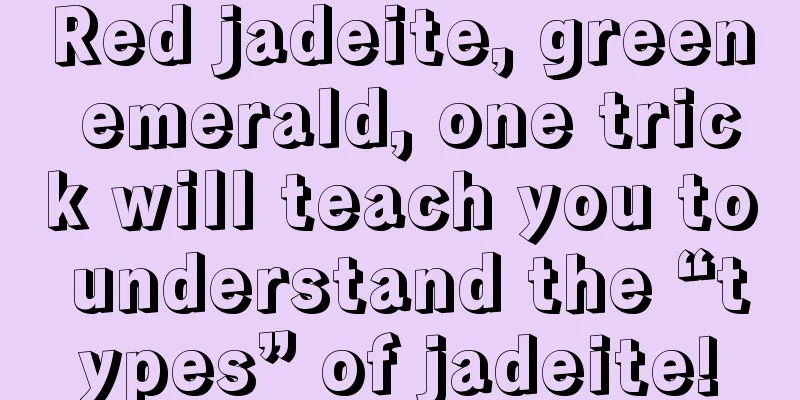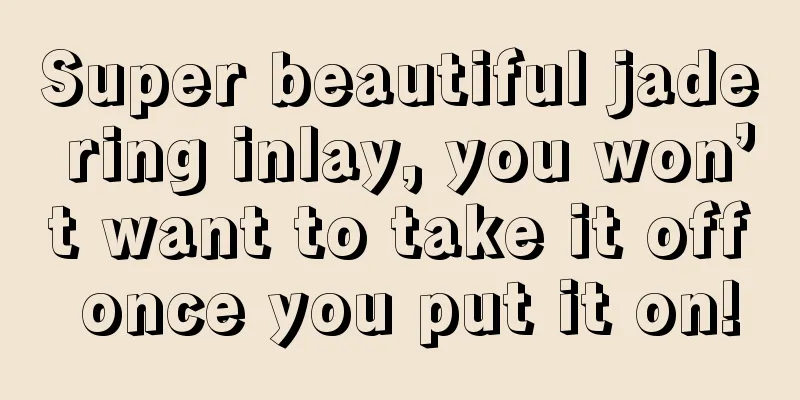Red jadeite, green emerald, one trick will teach you to understand the “types” of jadeite!

|
There is a saying in the jade industry: "Laymen look at the color, experts look at the quality." "Color" refers to the color of jadeite. It is easy to see the color. Even people who don't know much about jadeite can tell the quality of the color. Bright and rich colors are good products, while dull and bland colors are inferior products. However, the "type" cannot be easily seen. Newcomers to the industry need one or two years of learning before they can correctly evaluate the type and value of jade, so some unscrupulous merchants will use this to deceive consumers. There is a saying about jadeite that it has "36 waters, 72 beans, and 108 blues", which is used to indicate that the water, base, type, and color of jadeite are complex and difficult to identify. In fact, it is not that mysterious and difficult to understand. As long as you find vivid reference objects, you can understand the "type" of jade in one go! 1 Old pit glass As the name suggests, glass jade has the transparency of glass, its texture is pure and delicate without impurities, its color is also moist and uniform light green, light blue, etc., and its knocking sound is very crisp and pleasant. It is the best jade with the best "water head". Generally, glass-type jade is very light in color, and very few have bright colors. The more and richer the colors, the higher the value. Some jadeite has some color clusters and bands scattered on the base, which is called glass-type floating flower jadeite, while the pure green and full-color jadeite is glass-type imperial green jadeite, which is the best of the best. 2 Ice Without Sister Bao saying it explicitly, smart jade fans will be able to guess the characteristics of this type of jade from the name "ice type". Yes, the appearance and transparency of ice type jade are close to ice! It has a dense and warm texture and is translucent. Its water content is second only to glass jadeite, so it is easy to see internal flaws, cracks and impurities. There are many color varieties of ice jade, covering almost all colors of jade. Except for the gray and black ice jade, the prices of others are usually very high as long as the colors are pure and uniform. The color of most ice jade appears in the form of floating flowers, which is called ice jade with floating flowers. 3 Glutinous The word "glutinous" can only be understood but not described. It refers to the fineness of jade. It was really difficult to find a reference. The texture of glutinous jade is like a bowl of millet porridge simmered over a slow fire, with rice grains and rice soup blended into one. Its transparency is lower than that of glass and ice, and it is opaque. Its internal structure is clear and mostly coarse-grained. The value of glutinous jade is generally not as good as glass jade and ice jade, but if its color is bright and rich, it can make up for its shortcomings. The brightly colored glutinous jade on the market is very expensive. 4 Bean seeds The name "bean-type" is very vivid, because its constituent crystals are mostly short columnar, like beans arranged inside the jade, and the dividing lines of these crystals can be seen with the naked eye. Bean-type jade is a very common variety in the jade family. It has poor quality and belongs to the medium and low-grade jade. It is usually used to make medium-grade bracelets, accessories and carvings. In fact, bean-type jade itself is a very large family, which can be subdivided into nearly a dozen types, including bean green type, ice bean type, sugar bean type, etc. 5 Hibiscus species The transparency of the Hibiscus variety is between the Ice variety and the Glutinous variety, and its colors are mostly light green or light green without any yellowish hue. Because its color is similar to that of hibiscus, and it also has the beauty of "lotus emerging from clear water, naturally without any decoration", it was called "hibiscus species" in the early days. Now, due to its low output, it has become a high-end jade material. Although the green of hibiscus is not rich enough, it is pure and clear, and is very suitable for being made into jade bracelets. 6 Oil green The color of oily green jadeite is mostly dark green, but there are also dark green, light green and other colors, similar to the green glaze on ceramics. It has a fine texture, an oil-immersion feel, and high transparency, but the structural crystals are relatively rough and the outlines of the crystals can be discerned with the naked eye. The green color of Oily Green Jade is not pure enough, containing gray and blue tones, making it appear dull, so it can only be classified as medium or low-grade jade, and is mostly made into pendants, bracelets, etc.
fruit fcgc33 |
<<: Wrong jade care method, the more itchy the jade, the uglier it looks. Don't do it again
>>: Who says jadeite collection is priceless? That means you are looking in the wrong direction!
Recommend
As a jade novice, what should you know most if you want to invest in jade?
Man takes care of jade for three years, and jade ...
Where does the “cotton” in jade come from? What’s the difference with snowflake cotton?
As the saying goes, "There is no jade withou...
Definitions and Identification of A, B, C, B+C, and D Grade Jadeite
Beautiful jade can always touch the hearts of lov...
When buying jadeite, should you look at the quality or the color? Have you made the right choice?
Most people familiar with the jade industry have ...
Let’s talk about the four major levels of jadeite collection. What level are you at?
In fact, jadeite collection is a scientific thing...
Roll up your long black hair, walk lightly, look around
Kingfisher Blessings A hairpin is a piece of jewe...
What should you pay attention to when buying jadeite raw stones
1. The jade collection market is getting hotter a...
What misunderstandings should we avoid when choosing jadeite?
Nowadays, people's living standards are getti...
No one is perfect, and no jade is perfect. How to choose the jadeite you like?
First of all, everyone should know that jade is a...
There are certain rules for color matching of jade bracelets. This is how fashion darlings wear them. Have you ever known about this?
Bracelets are suitable for more people, both men ...
The jade Ruyi is so beautiful, but it becomes ugly once you wear it? You won't wear it!
As you wish, as I wish. The beautiful and auspici...
Is your jade waxed?
A few days ago, a customer asked us: I heard that...
Which should I choose between jade quality and color?
According to the transparency and moisture of jad...
Jade investment lecture begins
Since its establishment, the Jade Investment Summ...
The Yang Green Jadeite sheet material is cleverly carved into a sign using the color, and its value has increased several times!
This is a piece of jadeite with a color band runn...









